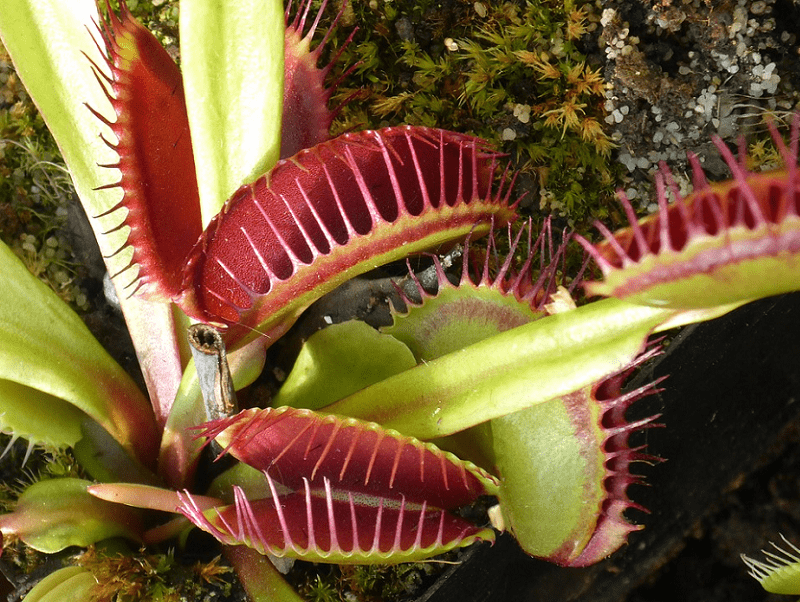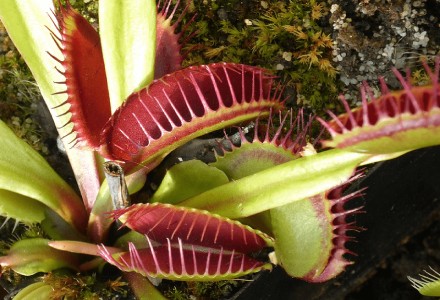
Public Domain Image
Venus Flytrap Facts
- The distinctive term of Venus Flytrap serves as the generally accepted common name of one of the most famous, and yet misunderstood, plants on earth. However, this amazing variety of flora also goes by a few other names. Among professional researchers, it goes by the much less pronounceable scientific name of the Dionaea muscipula.
- However, regardless of which name one uses to refer to the extremely impressive flora, this particular plant remains one of the great marvels of the natural world. Furthermore, a powerful aura of exotic mystery also continues to surround this fascinating species even today. The wonder and variety of Nature also extend to the incredible exceptions as well, it seems.
- This holds true due to the fact that, out of roughly 375,000 currently known plant species, only 660 (0.16%) evolved to be carnivorous in nature. But, even among its peers, this particular one stands out for a variety of unusual reasons. In point of fact, the great Charles Darwin himself called the Venus Flytrap one of the most wonderful plants in the world, in 1871.
- However, within its natural range, this truly marvelous plant now finds itself facing great peril. This holds true for several reasons. Therefore, the IUCN currently lists it as Vulnerable, on its Red List of Threatened Species. Finally, due to the nature of its habitat, it remains especially vulnerable to the dual threats posed by habitat loss and climate change.
Related Articles
Sundew Butterwort Waterwheel Plant
Venus Flytrap Physical Description
Although it does truly deserve its fame, the magnificent Venus Flytrap doe snot earn it accolades due to physical size. Firstly, that’s because the carnivorous plant typically attains an overall diameter measuring about 5 in (12.7 cm). Further, each individual plant generally produces between 5-6 separate stems. Each of these parts of the plant also usually have a covering of hinged leaves.
Secondly, though, the foliage of the awesome plant also merits attention. That occurs partly due to the fact that the edges of these leaves also display a row of daunting teeth-like filaments. In addition, these distinctive features fit together like the bars of a cell when the leaf closes. When activated, these close with impressive speed. In point of fact, they do so in roughly 1 second, trapping the unwary prey.
Thirdly, the parts of the Venus Flytrap that actually catch the creatures it feeds on grow to a respectable size, relative to the rest of the Angiosperm. This holds true because each individual trap commonly measures about 1 inch (2.5 cm) across. In addition, the incredible carnivorous species accomplishes its reproduction either by the spreading of seeds or through means of shoots.
- Kingdom: Plantae
- Phylum: Angiosperms
- Class: Eudicots
- Order: Caryophyllales
- Family: Droseraceae
- Genus: Dioaea
- Species: D. muscipula
Source: http://bit.ly/2F4RZGX
Venus Flytrap Distribution, Habitat, and Ecology
Part of the aura of mystery surrounding the fabulous Venus Flytrap, which remains even today, concerns its origins. This occurs because of the fact that the assumption held by many people, that it hails from a tropical environment, remains incorrect. In point of fact, this sincerely stunning species actually appears in the wild in only a tiny portion of the globe.
Even more precisely, to the astonishment of many people, the Angiosperm actually evolved to an extremely limited region in the United States, in North America. Furthermore, even within the confines of that restricted zone, it only naturally inhabits a tiny section of the east coast. To be exact, it evolved as endemic to a narrow strip of North Carolina and South Carolina.
Even further limiting its extremely small range, the variety of flora only dwells in the coastal plains of the two states. Quite remarkably, the entirety of its unique natural habitat range consists of an area extending roughly 56 mi (90 km) from the city of Wilmington, North Carolina, in all directions. Also, for the moment, no evidence exists of it ever appearing in any other region.
In its natural habitat the Venus Flytrap also tends to prefer areas of moist, acidic soil. This typically includes the understory of forest regions. The incredible species supplements the nourishment it derives from its environment with nutrients and moisture from small insects it consumes. These most often include ants and flies but may include other invertebrates, and even tiny frogs.
Species Sharing Its Range
Carolina Silverbell Cougar Carolina Wolf Spider
Check out our other articles on 10 Extraordinary Reptiles, Thresher Shark, Mount Erebus, Irrawaddy Dolphin, Yosemite Cave Pseudoscorpion, Plumed Basilisk, Greater Sage Grouse

